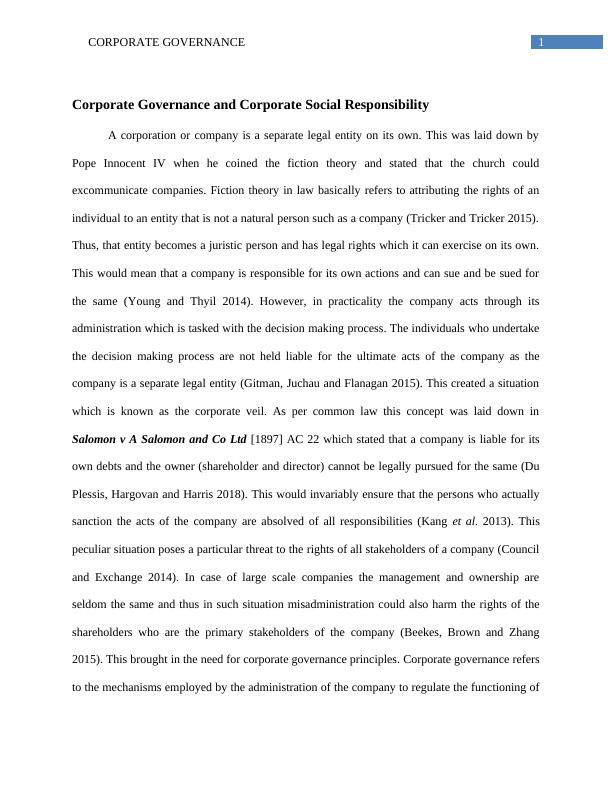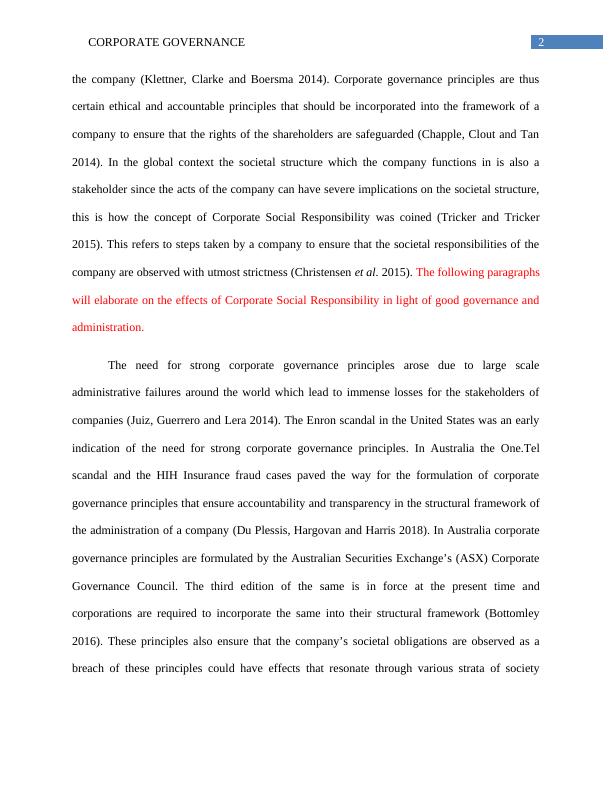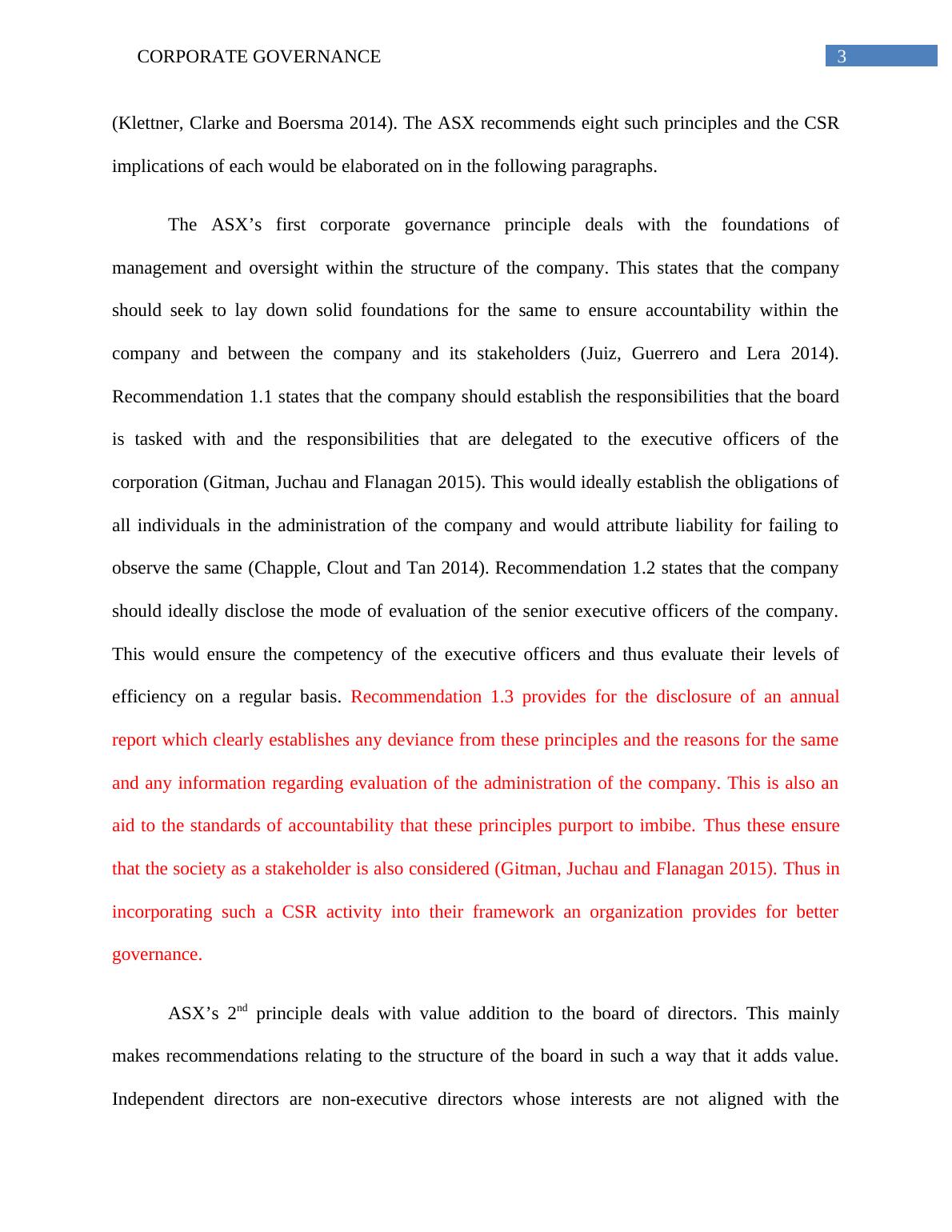Corporate Governance Assignment
14 Pages4258 Words27 Views
Added on 2021-05-31
Corporate Governance Assignment
Added on 2021-05-31
ShareRelated Documents
Running head: CORPORATE GOVERNANCE
CORPORATE GOVERNANCE
Name of the Student
Name of the University
Author Note
CORPORATE GOVERNANCE
Name of the Student
Name of the University
Author Note

1CORPORATE GOVERNANCE
Corporate Governance and Corporate Social Responsibility
A corporation or company is a separate legal entity on its own. This was laid down by
Pope Innocent IV when he coined the fiction theory and stated that the church could
excommunicate companies. Fiction theory in law basically refers to attributing the rights of an
individual to an entity that is not a natural person such as a company (Tricker and Tricker 2015).
Thus, that entity becomes a juristic person and has legal rights which it can exercise on its own.
This would mean that a company is responsible for its own actions and can sue and be sued for
the same (Young and Thyil 2014). However, in practicality the company acts through its
administration which is tasked with the decision making process. The individuals who undertake
the decision making process are not held liable for the ultimate acts of the company as the
company is a separate legal entity (Gitman, Juchau and Flanagan 2015). This created a situation
which is known as the corporate veil. As per common law this concept was laid down in
Salomon v A Salomon and Co Ltd [1897] AC 22 which stated that a company is liable for its
own debts and the owner (shareholder and director) cannot be legally pursued for the same (Du
Plessis, Hargovan and Harris 2018). This would invariably ensure that the persons who actually
sanction the acts of the company are absolved of all responsibilities (Kang et al. 2013). This
peculiar situation poses a particular threat to the rights of all stakeholders of a company (Council
and Exchange 2014). In case of large scale companies the management and ownership are
seldom the same and thus in such situation misadministration could also harm the rights of the
shareholders who are the primary stakeholders of the company (Beekes, Brown and Zhang
2015). This brought in the need for corporate governance principles. Corporate governance refers
to the mechanisms employed by the administration of the company to regulate the functioning of
Corporate Governance and Corporate Social Responsibility
A corporation or company is a separate legal entity on its own. This was laid down by
Pope Innocent IV when he coined the fiction theory and stated that the church could
excommunicate companies. Fiction theory in law basically refers to attributing the rights of an
individual to an entity that is not a natural person such as a company (Tricker and Tricker 2015).
Thus, that entity becomes a juristic person and has legal rights which it can exercise on its own.
This would mean that a company is responsible for its own actions and can sue and be sued for
the same (Young and Thyil 2014). However, in practicality the company acts through its
administration which is tasked with the decision making process. The individuals who undertake
the decision making process are not held liable for the ultimate acts of the company as the
company is a separate legal entity (Gitman, Juchau and Flanagan 2015). This created a situation
which is known as the corporate veil. As per common law this concept was laid down in
Salomon v A Salomon and Co Ltd [1897] AC 22 which stated that a company is liable for its
own debts and the owner (shareholder and director) cannot be legally pursued for the same (Du
Plessis, Hargovan and Harris 2018). This would invariably ensure that the persons who actually
sanction the acts of the company are absolved of all responsibilities (Kang et al. 2013). This
peculiar situation poses a particular threat to the rights of all stakeholders of a company (Council
and Exchange 2014). In case of large scale companies the management and ownership are
seldom the same and thus in such situation misadministration could also harm the rights of the
shareholders who are the primary stakeholders of the company (Beekes, Brown and Zhang
2015). This brought in the need for corporate governance principles. Corporate governance refers
to the mechanisms employed by the administration of the company to regulate the functioning of

2CORPORATE GOVERNANCE
the company (Klettner, Clarke and Boersma 2014). Corporate governance principles are thus
certain ethical and accountable principles that should be incorporated into the framework of a
company to ensure that the rights of the shareholders are safeguarded (Chapple, Clout and Tan
2014). In the global context the societal structure which the company functions in is also a
stakeholder since the acts of the company can have severe implications on the societal structure,
this is how the concept of Corporate Social Responsibility was coined (Tricker and Tricker
2015). This refers to steps taken by a company to ensure that the societal responsibilities of the
company are observed with utmost strictness (Christensen et al. 2015). The following paragraphs
will elaborate on the effects of Corporate Social Responsibility in light of good governance and
administration.
The need for strong corporate governance principles arose due to large scale
administrative failures around the world which lead to immense losses for the stakeholders of
companies (Juiz, Guerrero and Lera 2014). The Enron scandal in the United States was an early
indication of the need for strong corporate governance principles. In Australia the One.Tel
scandal and the HIH Insurance fraud cases paved the way for the formulation of corporate
governance principles that ensure accountability and transparency in the structural framework of
the administration of a company (Du Plessis, Hargovan and Harris 2018). In Australia corporate
governance principles are formulated by the Australian Securities Exchange’s (ASX) Corporate
Governance Council. The third edition of the same is in force at the present time and
corporations are required to incorporate the same into their structural framework (Bottomley
2016). These principles also ensure that the company’s societal obligations are observed as a
breach of these principles could have effects that resonate through various strata of society
the company (Klettner, Clarke and Boersma 2014). Corporate governance principles are thus
certain ethical and accountable principles that should be incorporated into the framework of a
company to ensure that the rights of the shareholders are safeguarded (Chapple, Clout and Tan
2014). In the global context the societal structure which the company functions in is also a
stakeholder since the acts of the company can have severe implications on the societal structure,
this is how the concept of Corporate Social Responsibility was coined (Tricker and Tricker
2015). This refers to steps taken by a company to ensure that the societal responsibilities of the
company are observed with utmost strictness (Christensen et al. 2015). The following paragraphs
will elaborate on the effects of Corporate Social Responsibility in light of good governance and
administration.
The need for strong corporate governance principles arose due to large scale
administrative failures around the world which lead to immense losses for the stakeholders of
companies (Juiz, Guerrero and Lera 2014). The Enron scandal in the United States was an early
indication of the need for strong corporate governance principles. In Australia the One.Tel
scandal and the HIH Insurance fraud cases paved the way for the formulation of corporate
governance principles that ensure accountability and transparency in the structural framework of
the administration of a company (Du Plessis, Hargovan and Harris 2018). In Australia corporate
governance principles are formulated by the Australian Securities Exchange’s (ASX) Corporate
Governance Council. The third edition of the same is in force at the present time and
corporations are required to incorporate the same into their structural framework (Bottomley
2016). These principles also ensure that the company’s societal obligations are observed as a
breach of these principles could have effects that resonate through various strata of society

3CORPORATE GOVERNANCE
(Klettner, Clarke and Boersma 2014). The ASX recommends eight such principles and the CSR
implications of each would be elaborated on in the following paragraphs.
The ASX’s first corporate governance principle deals with the foundations of
management and oversight within the structure of the company. This states that the company
should seek to lay down solid foundations for the same to ensure accountability within the
company and between the company and its stakeholders (Juiz, Guerrero and Lera 2014).
Recommendation 1.1 states that the company should establish the responsibilities that the board
is tasked with and the responsibilities that are delegated to the executive officers of the
corporation (Gitman, Juchau and Flanagan 2015). This would ideally establish the obligations of
all individuals in the administration of the company and would attribute liability for failing to
observe the same (Chapple, Clout and Tan 2014). Recommendation 1.2 states that the company
should ideally disclose the mode of evaluation of the senior executive officers of the company.
This would ensure the competency of the executive officers and thus evaluate their levels of
efficiency on a regular basis. Recommendation 1.3 provides for the disclosure of an annual
report which clearly establishes any deviance from these principles and the reasons for the same
and any information regarding evaluation of the administration of the company. This is also an
aid to the standards of accountability that these principles purport to imbibe. Thus these ensure
that the society as a stakeholder is also considered (Gitman, Juchau and Flanagan 2015). Thus in
incorporating such a CSR activity into their framework an organization provides for better
governance.
ASX’s 2nd principle deals with value addition to the board of directors. This mainly
makes recommendations relating to the structure of the board in such a way that it adds value.
Independent directors are non-executive directors whose interests are not aligned with the
(Klettner, Clarke and Boersma 2014). The ASX recommends eight such principles and the CSR
implications of each would be elaborated on in the following paragraphs.
The ASX’s first corporate governance principle deals with the foundations of
management and oversight within the structure of the company. This states that the company
should seek to lay down solid foundations for the same to ensure accountability within the
company and between the company and its stakeholders (Juiz, Guerrero and Lera 2014).
Recommendation 1.1 states that the company should establish the responsibilities that the board
is tasked with and the responsibilities that are delegated to the executive officers of the
corporation (Gitman, Juchau and Flanagan 2015). This would ideally establish the obligations of
all individuals in the administration of the company and would attribute liability for failing to
observe the same (Chapple, Clout and Tan 2014). Recommendation 1.2 states that the company
should ideally disclose the mode of evaluation of the senior executive officers of the company.
This would ensure the competency of the executive officers and thus evaluate their levels of
efficiency on a regular basis. Recommendation 1.3 provides for the disclosure of an annual
report which clearly establishes any deviance from these principles and the reasons for the same
and any information regarding evaluation of the administration of the company. This is also an
aid to the standards of accountability that these principles purport to imbibe. Thus these ensure
that the society as a stakeholder is also considered (Gitman, Juchau and Flanagan 2015). Thus in
incorporating such a CSR activity into their framework an organization provides for better
governance.
ASX’s 2nd principle deals with value addition to the board of directors. This mainly
makes recommendations relating to the structure of the board in such a way that it adds value.
Independent directors are non-executive directors whose interests are not aligned with the

End of preview
Want to access all the pages? Upload your documents or become a member.
Related Documents
Piercing of Corporate Veil in Australian Contextlg...
|13
|3525
|318
Corporate Veil and Limited Liability in International Business Lawlg...
|13
|4988
|284
Liability of a Holding Company for the Negligence of its Subsidiarylg...
|9
|2477
|184
Report on Application of Salomon Principle in Corporate Veillg...
|15
|3895
|54
Salomon is in the Shadow - Doclg...
|9
|2756
|102
Corporation Lawlg...
|8
|1847
|436
